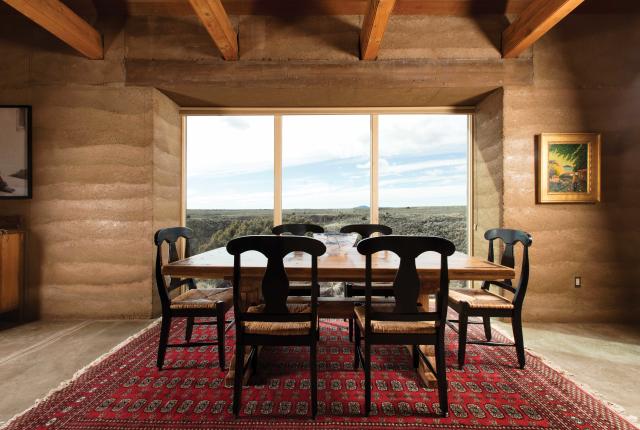Above: Rammed-earth walls and a glorious picture window help bring the outside in.
YOU ARE ALMOST UPON PETER AND MARIA SELZER'S HOUSE before you notice it, tucked down into the rocky landscape on the edge of a river canyon at the southwest end of Taos. The building so harmonizes with the environment that coyote tracks speckle the patio the snowy day I visit. A bobcat frequently visits, too, and Peter recently spotted a bighorn ram outside the floor-to-ceiling great-room windows.
“He was just standing there, staring in,” Peter says, then imitates the sheep’s thoughts: “Oh, it looks so nice and warm in there, and it’s so cold out here!”
The ram had the right idea. This beautiful U-shaped house is cozy even on the bleakest winter day, designed in a contemporary, streamlined style but still reflecting traditional local culture and aesthetics.
The central rammed-earth section is the heart of the home, with a main living area and kitchen, topped by a Territorial-style pitched roof. Peter, a part-time radiologist at Holy Cross Hospital in Taos, and Maria, his Italian-born wife, spend most of their time here. Let’s not forget Jade the parrot, an active participant in our conversation.
One side of the open-plan great room and kitchen looks to the western horizon over the Río Pueblo, running through the canyon below, the other onto the courtyard and the Sangre de Cristo Mountains beyond.
Maria’s idea of a perfect day is relaxing in the kitchen, enjoying the views on both sides. “Grab a good glass of Cabernet and read cookbooks!” She has hundreds to choose from.
Two updated Pueblo-style wings wrap around the courtyard, constructed of Pumice-Crete and fronted by portals. The bedroom wing enjoys views toward Taos Mountain. Throughout the house, large expanses of glass create an indoor/outdoor illusion.
Peter fell for Taos when he visited to ski in 1990. “It was not just a ski town, but a real place that happens to have world-class skiing nearby. I bought land in case I ever wanted to move here.” He later married Maria, and asked a ski buddy, San Francisco architect Nick Noyes, to design the house.
Noyes says he had relatives in Santa Fe who “had a beautiful old adobe that John Gaw Meem had worked on, so I had a sense of the soul of all this before we started.
Construction ran from 2005 to 2007, emphasizing sustainable and alternative building technologies in keeping with the spirit of Taos.
“It was a virgin piece of land on a river gorge across from pueblo land,” Noyes says. “I felt like … I can’t blow it! You have to respect that country. Can we settle the house into the landscape as much as possible, low-slung, breaking down the house mass as much as possible?” Hence the unusual choice of three wings with different looks, all evoking traditional New Mexico architecture.
“We wanted the same features but more modern and simple,” Peter says. For example, less fancy corbels—“slimmed down,” Noyes says, “so you get the intent of the decorative gesture, but reinterpreted.”
The Selzers and Noyeses frequently stayed at the Mabel Dodge Luhan house because they all love it, and it ended up providing perfect inspiration: understated, not overly embellished, warm and welcoming. The couple also wanted “a handmade look, not perfect, with an earthy feel to it.” That shows in the obviously hand-painted green Mexican bathroom tile, organic cracks in the concrete floors, and imperfections in the rammed-earth walls. “That’s the way it is,” Maria says. “It’s a comfortable feel.”
Builder Ian Forsberg recommended Boulder’s Martin Mosko to design the xeriscaped courtyard. A landscape architect and abbot of a Zen Buddhist temple, Mosko had built gardens for, among others, the Dalai Lama. His Japanese influence shows in the courtyard’s wandering pathways and bridges across ponds filled with water lilies, koi fish, and waterfalls.
“In American culture, the point is to get from A to Z as fast as possible,” Maria says. “But here there are no direct paths; everything is meandering.”
Mosko called the project “Dragon’s Cosmic Breath.” Rock formations suggest a dragon undulating through blue flowers (water), with red flowers (fire) spilling from his mouth. A mosaic along a wall that frames the Sangre de Cristos symbolizes the earth, from the garden soil up through snowcapped mountains to the sky.
“We sit out in the hot tub almost every night,” Peter says. “The night sky is phenomenal. Being here in this place, with these views … it’s always an experience.”
Regular contributor Tania Casselle is a Londoner who fell in love with Taos—and a Taos man—on her first road trip in New Mexico.


